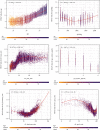Mortality prediction in ICU Using a Stacked Ensemble Model
- PMID: 36479315
- PMCID: PMC9722283
- DOI: 10.1155/2022/3938492
Mortality prediction in ICU Using a Stacked Ensemble Model
Abstract
Artificial intelligence (AI) technology has huge scope in developing models to predict the survival rate of critically ill patients in the intensive care unit (ICU). The availability of electronic clinical data has led to the widespread use of various machine learning approaches in this field. Innovative algorithms play a crucial role in boosting the performance of models. This study uses a stacked ensemble model to predict mortality in ICU by incorporating the clinical severity scoring results, in which several machine learning algorithms are employed to compare the performance. The experimental results show that the stacked ensemble model achieves good performance compared with the model without integrating the severity scoring results, which has the area under curve (AUC) of 0.879 and 0.862, respectively. To improve the performance of prediction, two feature subsets are obtained based on different feature selection techniques, labeled as SetS and SetT. Evaluation performances show that the SEM based on the SetS achieves a higher AUC value (0.879 and 0.860). Finally, the SHapley Additive exPlanations (SHAP) analysis is employed to interpret the correlation between the risk features and the outcome.
Copyright © 2022 Na Ren et al.
Conflict of interest statement
The authors have no conflicts of interest to declare.
Figures






Similar articles
-
Prognostic Assessment of COVID-19 in the Intensive Care Unit by Machine Learning Methods: Model Development and Validation.J Med Internet Res. 2020 Nov 11;22(11):e23128. doi: 10.2196/23128. J Med Internet Res. 2020. PMID: 33035175 Free PMC article.
-
Interpretable machine learning for 28-day all-cause in-hospital mortality prediction in critically ill patients with heart failure combined with hypertension: A retrospective cohort study based on medical information mart for intensive care database-IV and eICU databases.Front Cardiovasc Med. 2022 Oct 12;9:994359. doi: 10.3389/fcvm.2022.994359. eCollection 2022. Front Cardiovasc Med. 2022. PMID: 36312291 Free PMC article.
-
[Prediction of intensive care unit readmission for critically ill patients based on ensemble learning].Beijing Da Xue Xue Bao Yi Xue Ban. 2021 Jun 18;53(3):566-572. doi: 10.19723/j.issn.1671-167X.2021.03.021. Beijing Da Xue Xue Bao Yi Xue Ban. 2021. PMID: 34145862 Free PMC article. Chinese.
-
Predictive Modeling Using Artificial Intelligence and Machine Learning Algorithms on Electronic Health Record Data: Advantages and Challenges.Crit Care Clin. 2023 Oct;39(4):647-673. doi: 10.1016/j.ccc.2023.02.001. Epub 2023 Apr 26. Crit Care Clin. 2023. PMID: 37704332 Review.
-
Leveling Up: A Review of Machine Learning Models in the Cardiac ICU.Am J Med. 2023 Oct;136(10):979-984. doi: 10.1016/j.amjmed.2023.05.015. Epub 2023 Jun 19. Am J Med. 2023. PMID: 37343909 Review.
Cited by
-
Personalized and real time hemodynamic management in critical care using Dynamic Cohort Ensemble Learning (DynaCEL).NPJ Digit Med. 2025 Jul 24;8(1):474. doi: 10.1038/s41746-025-01863-0. NPJ Digit Med. 2025. PMID: 40707735 Free PMC article.
References
-
- Wang B., Ding S., Liu X., Li X., Li G. Predictive classification of ICU readmission using weight decay random forest. Future Generation Computer Systems . 2021;124:351–360. doi: 10.1016/j.future.2021.06.011. - DOI
-
- Kim S. H., Chan C. W., Olivares M., Escobar G. ICU admission control: an empirical study of capacity allocation and its implication for patient outcomes. Management Science . 2015;61(1):19–38. doi: 10.1287/mnsc.2014.2057. - DOI
MeSH terms
LinkOut - more resources
Full Text Sources

